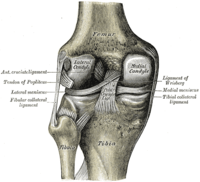
Photo from wikipedia
Background: Patellar dislocation is one of the most common knee injuries in the adolescent population. It is often combined with osteochondral fracture. The purpose of this study was to compare… Click to show full abstract
Background: Patellar dislocation is one of the most common knee injuries in the adolescent population. It is often combined with osteochondral fracture. The purpose of this study was to compare the outcomes between fixation and excision of osteochondral fractures not involving the bearing surface in adolescent patients with patellar dislocations. Methods: Patients who underwent surgery for osteochondral fracture following patellar dislocation in our institution from 2007 to 2014 were retrospectively evaluated. Visual analog scale (VAS) of pain and the International Knee Documentation Committee (IKDC) form were used to assess knee pain and function at follow-up. Patient satisfaction was evaluated. Differences in the values of variables among groups were assessed using t-test if equal variance or Mann–Whitney U-test if not equal variance. The Pearson's Chi-square test was applied for dichotomous variables if expected frequency was >5 or Fisher's exact test was applied if not. A value of P < 0.05 was considered statistically significant. Results: Forty-three patients were included, with the average age of 14.1 ± 2.3 (range, 9.0–17.0) years. Nineteen underwent fixation of osteochondral fractures and 24 did not. The average follow-up time was 28 ± 10 months. There was no significant difference in age, gender, follow-up time, causes of injury, times of dislocation, and location of osteochondral fracture between fixation and excision groups. The fixation group had a significantly longer surgery time (82 ± 14 min) and larger size of osteochondral fracture (2.30 ± 0.70 cm2) than the excision group (43 ± 10 min, 1.88 ± 0.62 cm2, respectively, t = 10.77, P < 0.01 and t = 0.84, P < 0.05). At the last follow-up, the average IKDC score in the fixation group (82.52 ± 8.71) was significantly lower than that in the excision group (89.51 ± 7.19, t = 2.65, P < 0.01). There was no significant difference in VAS of pain and patients' satisfaction. There were 7 (16%) patients with recurrent dislocation. Conclusion: Excision of osteochondral fractures has equivalent or better outcomes compared to fixation in adolescent patients with patellar dislocations when these fractures do not involve the bearing surface.
Journal Title: Chinese Medical Journal
Year Published: 2018
Link to full text (if available)
Share on Social Media: Sign Up to like & get
recommendations!